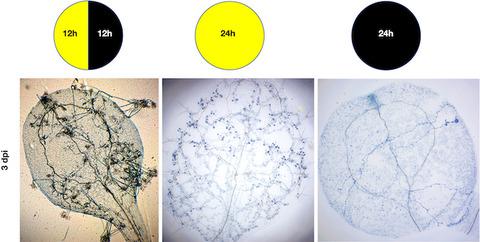当前位置:
X-MOL 学术
›
Plant Pathol.
›
论文详情
Our official English website, www.x-mol.net, welcomes your
feedback! (Note: you will need to create a separate account there.)
Effect of light and darkness on the growth and development of downy mildew pathogen Hyaloperonospora arabidopsidis
Plant Pathology ( IF 2.3 ) Pub Date : 2020-05-27 , DOI: 10.1111/ppa.13207 Osman Telli 1 , Catherine Jimenez‐Quiros 1 , John M. McDowell 2 , Mahmut Tör 1
Plant Pathology ( IF 2.3 ) Pub Date : 2020-05-27 , DOI: 10.1111/ppa.13207 Osman Telli 1 , Catherine Jimenez‐Quiros 1 , John M. McDowell 2 , Mahmut Tör 1
Affiliation

|
Disease development in plants requires a susceptible host, a virulent pathogen, and a favourable environment. Oomycete pathogens cause many important diseases and have evolved sophisticated molecular mechanisms to manipulate their hosts. Day length has been shown to impact plant‐oomycete interactions but a need exists for a tractable reference system to understand the mechanistic interplay between light regulation, oomycete pathogen virulence, and plant host immunity. Here we present data demonstrating that light is a critical factor in the interaction between Arabidopsis thaliana and its naturally occurring downy mildew pathogen Hyaloperonospora arabidopsidis (Hpa). We investigated the role of light on spore germination, mycelium development, sporulation and oospore formation of Hpa, along with defence responses in the host. We observed abundant Hpa sporulation on compatible Arabidopsis under day lengths ranging from 10 to 14 hours. Contrastingly, exposure to constant light or constant dark suppressed sporulation. Exposure to constant dark suppressed spore germination, mycelial development and oospore formation. Interestingly, exposure to constant light stimulated spore germination, mycelial development and oospore formation. A biomarker of plant immune system activation was induced under both constant light and constant dark. Altogether, these findings demonstrate that Hpa has the molecular mechanisms to perceive and respond to light and that both the host and pathogen responses are influenced by the light regime. Therefore, this pathosystem can be used for investigations to understand the molecular mechanisms through which oomycete pathogens like Hpa perceive and integrate light signals, and how light influences pathogen virulence and host immunity during their interactions.
中文翻译:

明暗对霜霉病病原Haloperonospora arabidopsidis生长发育的影响
植物的疾病发展需要易感宿主、有毒病原体和有利的环境。卵菌纲病原体会引起许多重要的疾病,并且已经进化出复杂的分子机制来操纵它们的宿主。日长已被证明会影响植物 - 卵菌相互作用,但需要一个易于处理的参考系统来了解光调节、卵菌病原体毒力和植物宿主免疫之间的相互作用机制。在这里,我们提供的数据表明,光是拟南芥与其自然发生的霜霉病病原体 Hyaloperonospora arabidopsidis (Hpa) 之间相互作用的关键因素。我们研究了光对 Hpa 的孢子萌发、菌丝体发育、孢子形成和卵孢子形成的作用,以及宿主的防御反应。我们在 10 到 14 小时的日长下观察到相容的拟南芥上大量的 Hpa 孢子形成。相比之下,持续光照或持续黑暗会抑制孢子形成。暴露在恒定的黑暗中会抑制孢子萌发、菌丝体发育和卵孢子形成。有趣的是,持续光照刺激孢子萌发、菌丝体发育和卵孢子形成。在恒定光照和恒定黑暗下诱导植物免疫系统激活的生物标志物。总而言之,这些发现表明 Hpa 具有感知和响应光的分子机制,并且宿主和病原体的反应都受光状态的影响。所以,
更新日期:2020-05-27
中文翻译:

明暗对霜霉病病原Haloperonospora arabidopsidis生长发育的影响
植物的疾病发展需要易感宿主、有毒病原体和有利的环境。卵菌纲病原体会引起许多重要的疾病,并且已经进化出复杂的分子机制来操纵它们的宿主。日长已被证明会影响植物 - 卵菌相互作用,但需要一个易于处理的参考系统来了解光调节、卵菌病原体毒力和植物宿主免疫之间的相互作用机制。在这里,我们提供的数据表明,光是拟南芥与其自然发生的霜霉病病原体 Hyaloperonospora arabidopsidis (Hpa) 之间相互作用的关键因素。我们研究了光对 Hpa 的孢子萌发、菌丝体发育、孢子形成和卵孢子形成的作用,以及宿主的防御反应。我们在 10 到 14 小时的日长下观察到相容的拟南芥上大量的 Hpa 孢子形成。相比之下,持续光照或持续黑暗会抑制孢子形成。暴露在恒定的黑暗中会抑制孢子萌发、菌丝体发育和卵孢子形成。有趣的是,持续光照刺激孢子萌发、菌丝体发育和卵孢子形成。在恒定光照和恒定黑暗下诱导植物免疫系统激活的生物标志物。总而言之,这些发现表明 Hpa 具有感知和响应光的分子机制,并且宿主和病原体的反应都受光状态的影响。所以,











































 京公网安备 11010802027423号
京公网安备 11010802027423号